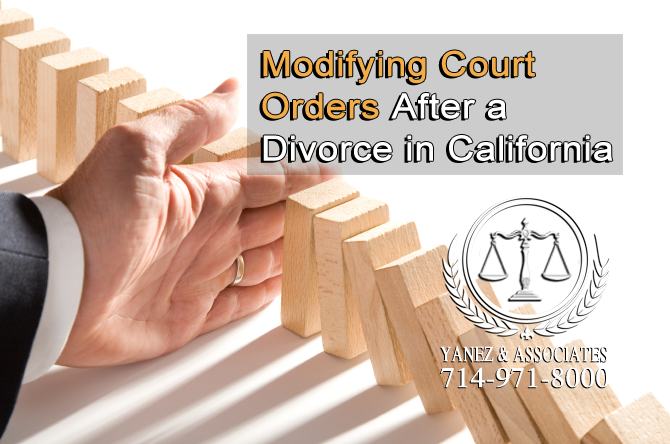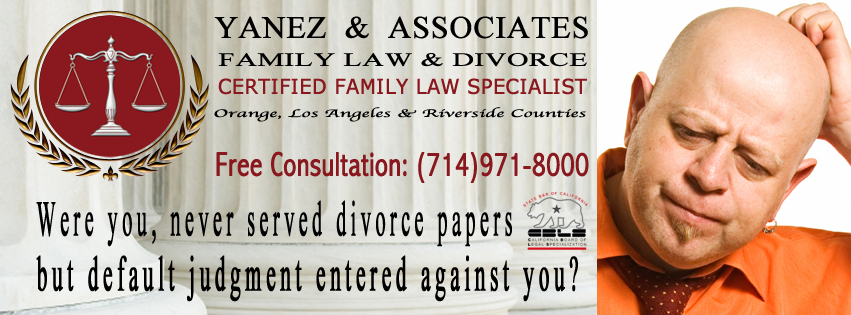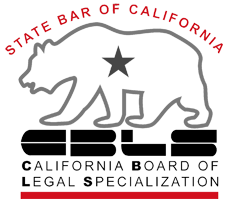I was Never Served with Divorce Papers, but a Default Judgment Was Entered Against Me in OC California. Now What?
FAQ: A default judgment was entered against me in Orange County, California, but I was not served with the divorce petition, what can I do now? (never served divorce papers but default judgment entered)
There are few cases when a default judgment should be granted without serving the respondent with divorce papers, but it is possible. Under certain circumstances, if a default judgment is entered against you and you have not been served with divorce papers, you may file a motion to set aside the default judgment that has been entered against you.
However, depending on the specifics of your case, the process may vary. You should always discuss the details of your case with a qualified divorce attorney before taking legal action.
What is Setting a Judgment Aside?

When you file a motion to set aside the default judgment that was entered against you, it means you want to overturn the judgment, or undo the divorce as it was granted.
You cannot prevent your spouse or partner from obtaining a divorce, but you can opt to play a role in the outcome rather than allowing a default judgment to be granted.
Usually, if you are not happy with the default judgment, this is your best option to change the results of your divorce.
You may file a motion to set aside or reverse a default judgment in a divorce in California for years after the judgment is granted, however, it is usually best to do so as soon as you are aware of the entry of the default judgment.
The processes are different depending on when you decide to file the motion, and under what circumstances.
Time Frames for Filing a Motion to Set Aside a Default Judgment

If you weren’t served with the original petition and summons for divorce, and a default judgment was entered against you in Orange County, you may file a Motion to set aside the judgment.
According to the Code of Civil Procedure, section 473, as long as the default judgment was entered within the last six months, you may file a Motion to Set Aside Default Judgment to reverse the default judgment.
If the default judgment was entered between six months and two years ago, you would instead file a Motion to Set Aside Default Judgment under the Family Code, section 2121.
Lastly, if the default judgment was entered more than two years ago, you’ll need to file a separate action that requests that the judgment is set aside.
When Can a Judgment be Set Aside in California?

There are several reasons why a judgment can be set aside in California. When it comes to setting aside a default divorce judgment, as stated above: sooner is better.
Code of Civil Procedure: 473 - Mistake, Inadvertence, Surprise, or Excusable Neglect
Within the first six months, you may request that the judge set aside or reverse a default if the judgment was entered due to a mistake, excusable neglect, inadvertence, or surprise.
If you never received your divorce paperwork, the court should not have granted the divorce unless your spouse or partner took all measures necessary to locate and serve you. However, in some cases, mistakes, inadvertence, surprise circumstances, or excusable neglect can play a role in entering the judgment.
Under this code, you may have been served with divorce papers but not understood the paperwork or you may have misplaced it, your attorney may have made a mistake, the court may have made a mistake, etc. Certain circumstances that fit the above situations may reverse the judgment filed against you.
However, remember that you are limited to six months to file for this reason, and the sooner you file, the better your chances for reversing the default.
Family Code, Section 2121 - Fraud & Duress
According to section 2121 of the Family Code, when you can show that the following are true, you may use this code to reverse the default judgment in your divorce.
• The other party in the divorce is guilty of fraud, duress, perjury, mistake of law, or failure to disclose (failing to serve you with divorce papers qualifies here), and
• The reversal of judgment, or changing the original judgment, would materially (significantly) benefit you, as the moving party.
You must be able to show that both of the above are true in order for this method to work. If your spouse or partner did not serve you with divorce papers, and you were not aware that the divorce was taking place, this qualifies as fraud in California.
How to File a Motion to Set Aside a Default Judgment in California
Remember that the sooner you file your paperwork, the better off you will be.
To file a motion to set aside a default judgment in California, you’ll need to fill out a form called a Notice of Motion to Vacate Judgment and Declaration. It needs to be filed with the court clerk, who will then give you a date and time for your hearing. At this hearing, the judge will decide whether or not to cancel the default judgment.
If the judge overturns the default...
At your trial, be prepared with your side of the story. You should be able to show that the judgment should be overturned for one of the reasons listed above.
To prepare for the hearing, discuss your case with your attorney. If the judge does decide to reverse the judgment, you will either have a new trial right away, or it will be rescheduled for another date. In most cases, with a divorce, it will be rescheduled for another date. However, you should have an idea of what you would like the terms of your divorce agreement to be, so it is a good idea to have this prepared ahead of time.
If the judge does not overturn the default…
In the case that your motion to set the judgment aside fails, you have 10 days following the judge’s decision to file an appeal.
You also have the option to apply to modify any of the court orders that are associated with your divorce, especially those associated with support payments and child custody or visitation.
Modifying Court Orders After a Divorce in California

Planning on Modifying a Child Support Order, Spousal or Partner Support Order or a Child Custody Order in OC California?
Orders relating to support and child custody or visitation may be (and often are) modified after they have been created. Depending on the order and the terms listed within it, a court order can be more or less difficult to modify. However, modifying a property division order is rarely permitted, so your best bet in the case of property division is to file a motion to set aside the judgment.
Modifying a Child Support Order in California
In order to modify a child support order in California, there must have been a significant change in circumstances since the last court order was created. Usually, child support is created based on what the child needs and what the parents are able to provide. The following are examples of what might constitute a significant change in circumstances in a child custody modification case.
• The income of the parents has either increased or decreased;
• Either parent is no longer able to provide due to job loss, incarceration, hospitalization, etc.;
• Either parent has another child;
• There have been significant modifications to the child custody agreement;
• The child’s needs have changed due to age, health, participation in activities, etc.;
• California modifies the law used to calculate child support.
To modify your child support order, you may ask your local child support agency to open a case, or ask the court yourself. Remember that until you legally modify the order, you are obligated to follow it without exception.
Modifying a Spousal or Partner Support Order in California
Spousal support orders may be changed for many reasons, and either spouse can ask that the court change a spousal support order in California at any time. Some spousal support orders expire on their own, depending on the terms of the order.
In order for the court to change you spousal support order, you’ll need to show that there has been a significant change in circumstances. Examples are as follows:
• If the receiving spouse remarries;
• If either spouse has a change in employment or in income;
• The receiving spouse no longer needs support;
• The receiving spouse is not making a good faith effort at becoming self-sufficient, etc.
To modify your spousal support order, you will need to ask the court. Remember that until you legally modify the order, you are obligated to follow it without exception.
Modifying a Child Custody Order in California
Child custody and visitation orders should always be made in the best interest of the child. If you want to modify the custody order that was included with your default divorce judgment, you will need a good reason to do so - and one that is based on your child’s needs rather than your own.
Were you, never served divorce papers but default judgment entered against you? Time to contact our California Divorce Attorneys located in Orange

If you were notified that a default judgment was entered against you in California, and you were never served with divorce papers, you are most likely eligible to file a motion to set aside the default judgment. Contact the attorneys at Yanez & Associates today to schedule your free initial consultation and discuss your case with a highly skilled family lawyer.









